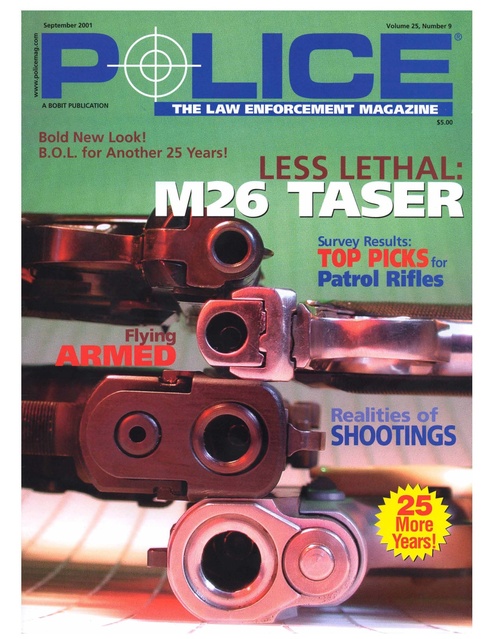Taser Police Mag Less Lethal M26 Article Sept 2001
Download original document:

Document text

Document text
This text is machine-read, and may contain errors. Check the original document to verify accuracy.
Volume 25. Number 9 ® Su rye Results: 1r . for Patrol Rifles The M26 TASER from TASER International offers a less-lethal ability to point and 'smite' from a safe distance. -He i) D 2. Is showing an obvious sign of "min d-body separation" such as self-mutilation, which clearly demonstrates that pain compliance techniques would likely be ineffective? M26 Advanced TASER The name is familiar to veteran officers, and the TASER is once again a "hot topic" in resistance control circles. The newest version of this 35-year-old technology is the M26 Advanced TASER and it offers a number of improvements over earlier devices, including: • Twenty one-foot maximum effective range. • 26 watts versus 7 watts of stopping power. • Handling and deployment characteristics similar to a semi-automatic pistol. • Battery status "ready" light. • Trigger does not have to be continuously held back to transmit the energy. • Data port tracks use history. The M26 is a black plastic "conducted energy weapon" that looks like a semi-automatic pistol. Depending on your perspective, this could be good or bad. The weapon is loaded by taking a live cartridge in one hand and the M26 in the other. Ensure the safety is down and point the weapon in a safe direction. Squeeze the release buttons on each side of the cartridge with thumb and index finger and place it firmly into the open, muzzle end . The cartridge cannot be put in upside down or backwards. policemag.com Septe mber 2001 The weapon can be carried in a variety of ways, with the most common and practical methods utilizing the two holsters available from the manufacturer. One is a black nylon "leg drop " that attaches in seconds to the weak side of an officers duty belt. The second is a conventional belt mount, which requires the officer to wear the M26 during the entire shift. This clearly ensures ready availability should a spontaneous event occur. Likewise, a gun on each hip will generate more than a casual glance from the citizens you meet on the street! Deploying Moving the safety into the "up" position arms the weapon. Immediately, a red laser dot is projected from the front and a flashing red "batt ery indicator" is visible at the rear. The laser dot is placed on the intended target and the trigger/switch is pulled. Two small probes are propelled at 175 feet per second at distances up to 15 or 21 feet (depending on the cartridge ) by non-pyrotechnic compressed nitrogen. The top probe is designed to strik e within an inch of the laser dot. The bottom probe is designed to,strike directly below at an 8-degree trajectory. This causes a spread of roughly one-foot for every seven feet of travel. The probes are connected to the weapon by high-voltage insulated wire . When contact occurs, electrical pulses are transmitted into the suspect's bod y. Th e probes are able to deliver their electrical charge through two inches of clothing. The transmission continues for five seconds regardless of the trigger position, unless stopped by the operator moving the safety into the "down" position . According to the manufacturer's literature, when th e current is applied it "interferes with and overrides the body's neuromuscular system and voluntary muscle control is lost POLICE 15 This was followed by a practical test involving twenty-three volunteers. Many were veterans of earlier seven-watt TASER tests and all had been subjected to direct OC exposure. Mats were placed on the floor and "spotters" positioned beside each person. Probes were attached and the participants were given foam batons. They were then asked to focus all of their attention on the TASER operator and attempt to attack him. All twenty-three officers were fully and immediately incapacitated by the M26. Twenty-one experienced a dynamic response including a high-speed movement off their feet. Testssuch as this are interesting but officers should be cau- between the two dart points. As a result of this current being delivered into a subject, they will usually fall to a grounded position or freeze in place." Interesting. Test ing The M26 was then put through a series of tests. The operator's manual was followed verbatim and the M26 performed from a function-perspective as intended. It L..-..............~ fit in the holsters "SMSU" cuts show the type of selfwell and the units destructive behavior often observed were readily acces- w ith potentially suicidal people. sible. The cartridges loaded and unloaded easily and test firing occurred at ranges up to 21 feet. The top probe contacted the target at or near the laser dot and the lower probe spread consistent with the printed literature. Those who are armed and non -assa ultive need to be taken into custody, but their actions don 't justify the use of tools that would risk ve ry much injury. • Have a low tolerance for pain - unlike many suspects. • Lack true motivation to focus and Above , Tase r probes after being fired. Right, An office r demonstrates how to access his duty firearm mounted on his strong side and t he M26 Taser mounted on his weak side. tioned against taking the dramatic results and assuming such outcomes are guaranteed on the street. Several thousand controlled OC exposures strongly suggest that officers who participate in such tests generally: The (at's Meow? This is not a perfect tool. The electrical impulse has ignited alcohol based OC sprays that were on suspects prior to deployment and in one case several ' years ago a probe was embedded in a suspects eye Likewise, based on several thousand U.S. and Canadian field tests and over 200 documented street encounters, the M26 Advanced TASER appears to offer a less lethal incapacitation capability that has simply not been available before . When an agency is seeking a balance between the need to incapacitate and the acceptability of the potential injury outcome, I'm not sure anything else in law enforcement can compare to this kind of technology. -$Circle Reade r No. 200 on Reader Service Card fight through the effects- unlikemany suspects. • Are very susceptible to the psychological processes created by apprehension and the subconscious modeling of behavior that often occurs in such group environments. Steve Ijames is a major on theSpringfield (Mo.) Police Department andan internationally known expert on less-lethal force options. He is a regular contributor to Police. He's still waiting for someone to invent a "real" Phaser ...





